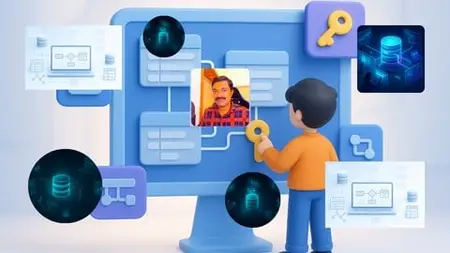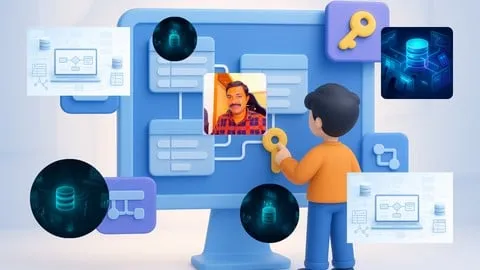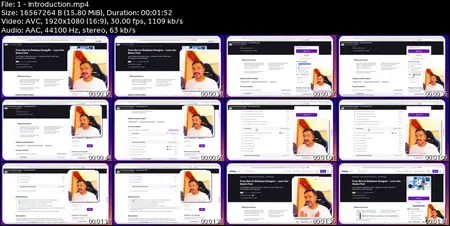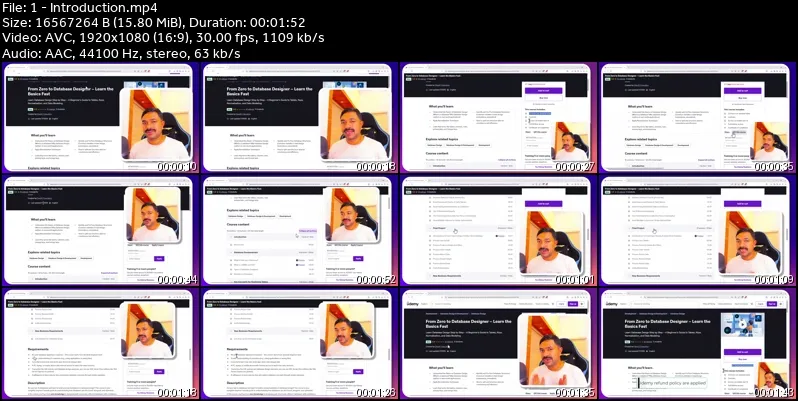From Zero to Database Designer – Learn the Basics Fast
MP4 | Video: h264, 1920x1080 | Audio: AAC, 44.1 KHz
Language: English (US) | Size: 2.43 GB | Duration: 3h 19m
MP4 | Video: h264, 1920x1080 | Audio: AAC, 44.1 KHz
Language: English (US) | Size: 2.43 GB | Duration: 3h 19m
Learn Database Design Step by Step – A Beginner’s Guide to Tables, Keys, Normalization, and Data Modeling
What you'll learn
Understand the Basics of Database Design (What is a database? Why database design matters in real-world applications)
Identify and Fix Poor Database Structures (Common mistakes in bad design (redundancy, anomalies))
Apply Normalization Techniques
How to split and structure data for consistency and efficiency
Learn Key terms like tables, columns, rows, primary keys, and foreign keys
Requirements
No prior database experience required — this course starts from absolute beginner level
A basic understanding of computers (e.g., using applications or saving files)
Curiosity to learn how real-world apps store and manage data
A PC, laptop, or mobile device with internet access to watch the video lectures.
To practice the SQL queries and database design exercises, you can use SQL Server (free editions like SQL Server Express are perfect).
A willingness to learn step by step and explore database concepts through simple examples.
We will use free version of SQL server (DBMS) 7 SQL Server Management Studio
Description
Are you new to databases and want to build a strong foundation in database design? This course is your complete beginner-friendly guide to understanding how databases are structured, designed, and optimized.In this course, you’ll go from zero knowledge to designing well-structured, efficient databases with confidence. Whether you're a student, aspiring developer, analyst, or just curious about how data is organized, this course gives you everything you need to get started the right way. What You’ll Learn:What databases are and how they workHow to structure tables using data types, primary keys, and foreign keysWhat normalization is, and how it helps reduce redundancyThe Database Development Lifecycle and how to analyze real-world requirementsBasics of data modeling: entities, relationships, cardinality, and modalityThe difference between 1NF, 2NF, and 3NF with practical examplesCommon database design mistakes and how to avoid themWhen and why to use denormalization Course Structure:This course is structured into 8 easy-to-follow sections:Introduction – Get a quick overview of what’s comingDatabase Fundamentals – Learn the foundation of databases, DBMS, and SQLKey Concepts for Designing Tables – Understand data types, constraints, and keysDatabase Design Process – Learn the lifecycle from planning to implementationData Modeling Basics – Dive into entities, attributes, and relationshipsKeys & Relationships – Explore design structure and its advantagesNormalization Techniques – Learn how to remove data anomalies step-by-stepCommon Design Mistakes – Avoid beginner pitfalls with real-world advice
Who this course is for:
Aspiring Developers & Software Engineers – who want to learn database design fundamentals, Computer Science Students – looking to strengthen their understanding of normalization, ERDs, and schema creation, Data Analysts / BI Beginners – who work with data and want to understand how it’s structured behind the scenes, Anyone Curious About Databases – whether you’re launching an app, managing school records, or exploring data careers





